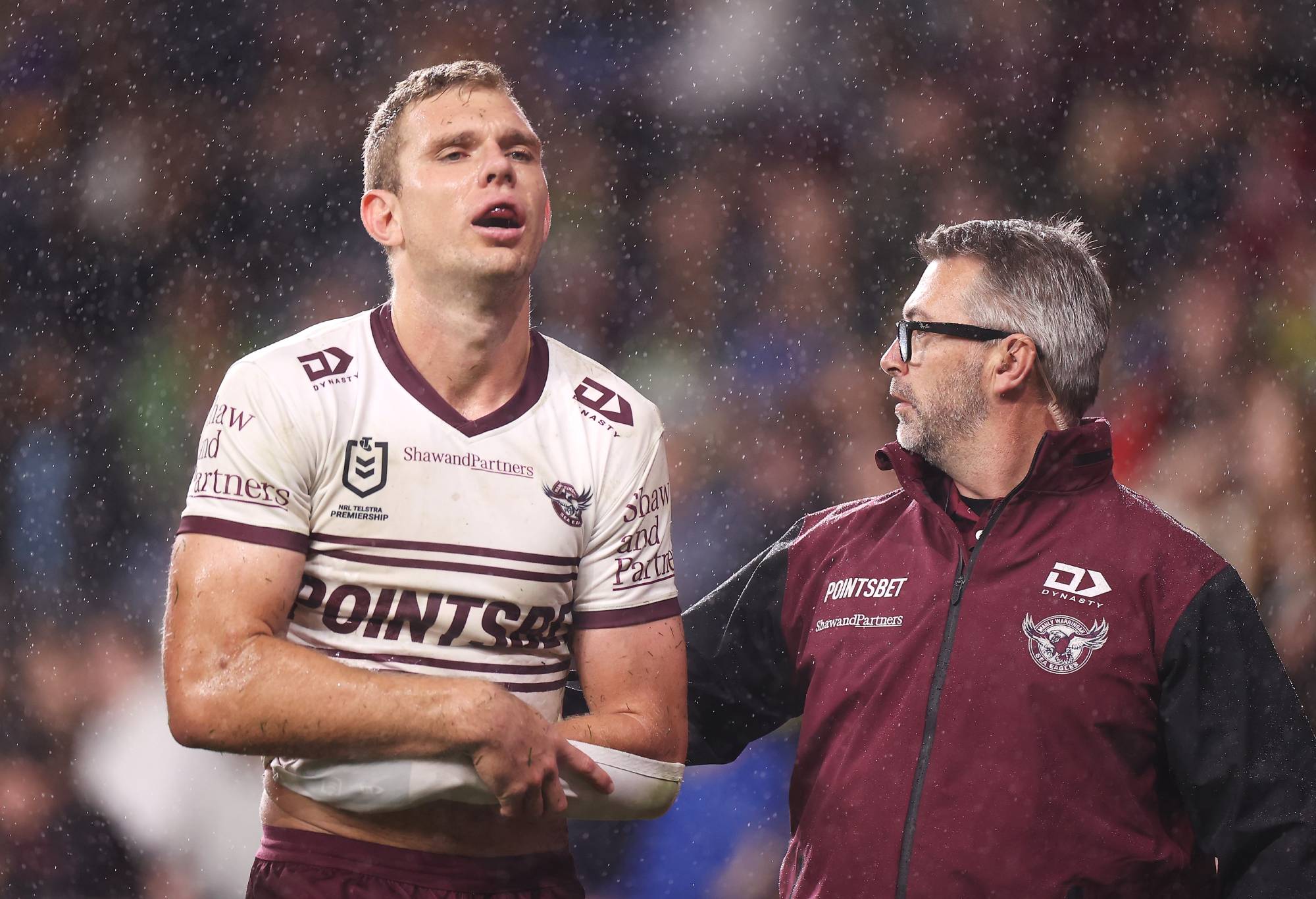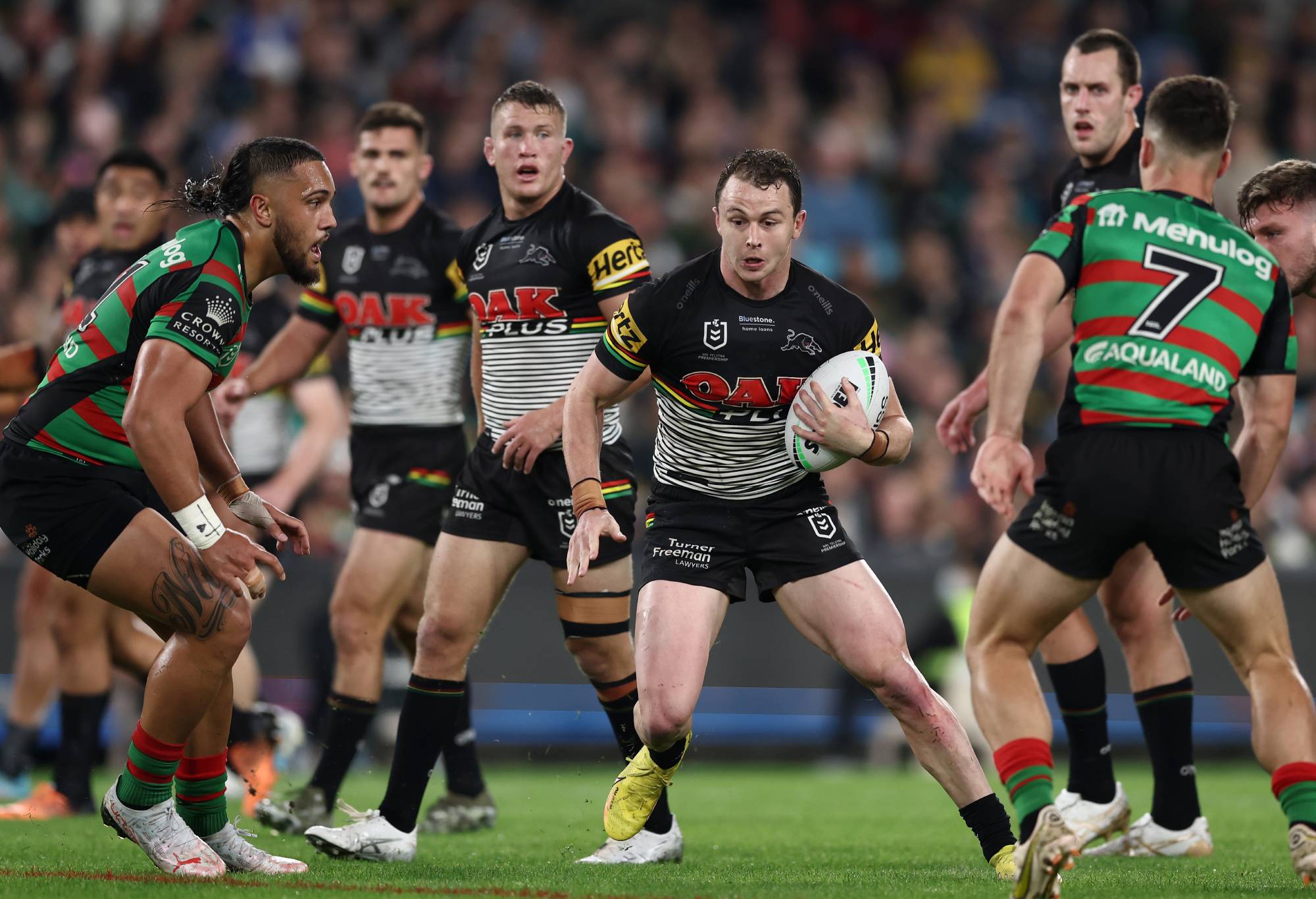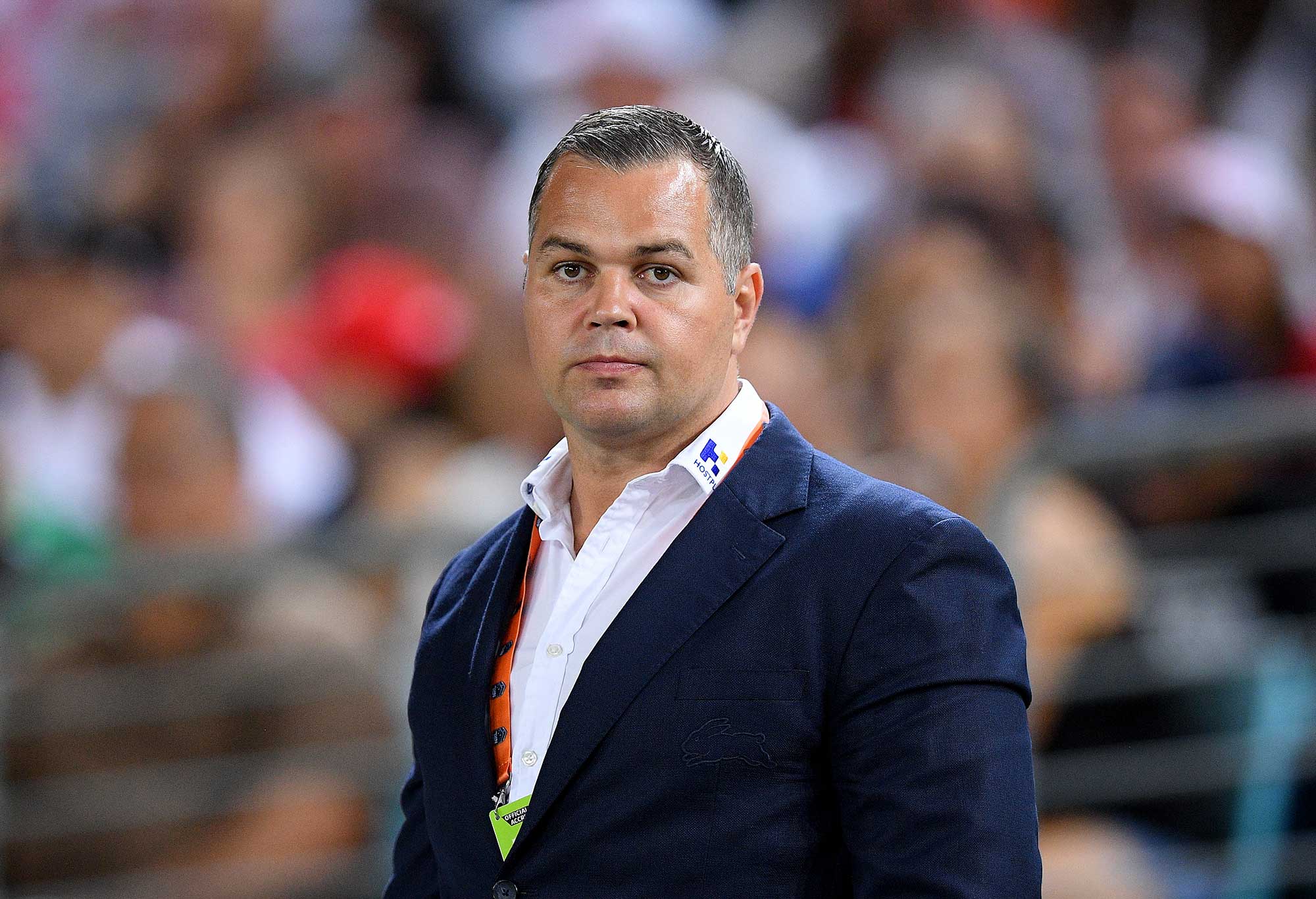Amusement over Daly Cherry-Evans' moment of niggle with a former teammate
He was trying to slow the play the ball from Brian Kelly - and the look on his face showed he knew what he…
There comes a time in every good fullback’s life where a club legend calls for them to move to the centres to get more ball or avoid injury or something like that.
Latrell Mitchell, literally the best attacking fullback in the league, gets it a lot. Tom Trbojevic is the latest to cop it, with Manly old boy Peter Peters going public on his desire to see their best player influence the game less.
Turbo and Latrell have suffered from hamstring problems in recent years – though, remember, the knock that ended Tom’s 2022 was a shoulder injury – and have spent time in the USA with Bill Knowles, who is to hamstrings what Hans-Wilhelm Müller-Wohlfahrt was to knees in the early 2000s.
Manly weren’t having any of talk of a positional change. “I don’t see too much merit in it,” said the man himself at a media conference called to celebrate his return from America.
“Everyone throws it out there, and I understand the thought process behind it, but I enjoy playing fullback, and it’s where I play my best footy.”
New coach Anthony Seibold agrees: “People will say there’s a bigger workload, but the workload has nothing to do with Tom’s hamstring history. It’s the running mechanics.
“Regardless of whether he played centre, fullback or any other position, it won’t have an impact on his injury history, so that shuts down that.”
As you can tell from the tone, the desire to see gun fullbacks move to the centres is not one that holds much merit.
Fullbacks play in their position because they have a specific set of skills that make them ideal for the task at hand, and that differs considerably from anywhere else on the field.
They’re a creator, a yardage player, a defensive organiser and kick fielder, expected to score and stop tries. There’s a reason their wages are among the highest of any position.

(Photo by Mark Kolbe/Getty Images)
We could probably say there are five truly elite fullbacks in the comp: James Tedesco, Latrell Mitchell, Dylan Edwards, Ryan Papenhuyzen and Turbo.
Kalyn Ponga is now a five-eighth, Cameron Munster is back in the halves too and Joey Manu is yet to permanently shift to the back, though he’d make it a top six if he did.
The likes of Reece Walsh, Clint Gutherson and Scott Drinkwater are just one peg down, along with Sam Tomkins and Jai Field on the other side of the world.
Of our big five, the stats tell us some very interesting things about what those fullbacks do in their systems.
It’s worth pointing out now that a) fullback is among the most systematically interesting roles on the field, because they all get used differently and b) of our five, all but Trbojevic play in highly functional systems designed to get the most out of them.
Edwards dominates anything to do with a set start, but lags in creativity. Latrell is the opposite, all attacking upside but very little yardage work.
Papi is the most threatening offensive runner and makes hardly any defensive errors, but his returning is dreadful. Tedesco isn’t top of anything, but he’s close to the top of everything, which is why he gets picked for every rep team.
So whither Turbo? He barely made the six game cut off used for sample size (he played seven) and produced some very strange numbers.

(Photo by Matt King/Getty Images)
He was up there with Teddy and Edwards in general yardage, but his kick return metres were horrendous. He was above Papi for defensive security, but his offensive handling was terrible. In attack, he offered very little beyond trucking the ball in.
I ran his limited 2022 numbers and then, to see the contrast, threw in the 2021 Turbo to see where it would land: he out-Teddied Teddy, out-Edwardsed Edwards, out-Latrelled Latrell and out-Papied Papi.
Even with the asterisk of 2021 statflation, it was striking to see how much better he was than everyone else in all the categories that they were good at too. He even out-Turboed Turbo, albeit by making even more handling errors.
Trbojevic’s problem, last year at least, was as much structural as it was anything to do with himself. He bullied the league in 2021 by being the best player, of course, but also the player most suited to the rules that came in and were largely dumped after just one year.
There was a debate prior to his injury about whether sides had worked Manly out, because they managed to effectively nullify the fullback by forcing him to take hard carries of the sort that Edwards thrives on. With the greatest respect to Dylan Edwards, those are runs that player as creative as Tom Trbojevic should not be taking.
I actually put this to Turbo in an interview after their win over the Bulldogs early in the year, asking him why he “did doggies”, as the Pommy parlance has it for when you take the tough stuff for the team. He didn’t know what the phrase meant, but when I explained it to him, he gushed about how much work he wanted to do for the other lads.

Anthony Seibold (AAP Image/Dan Himbrechts)
Unsurprising, but the man needs to be saved for himself. You don’t take the Ferrari to the shops when you have a Camry in the garage.
This is something that Seibold can address. Having Reuben Garrick – who is essentially a Dylan Edwards clone when he plays at 1 – back on a wing can help, because he should be taking all the doggies for his fullback.
Not having Jason Saab – out until mid-season with an ACL tear – would help, because for all his speed, he rated dead last off all NRL wingers for tackle breaks, and among the worst for total runs, post-contact metres and play the ball speed.
Christian Tuipulotu, however, is above average in most of that good stuff and presents a decent option to start.
Some of the reasoning for Manly’s poor wing production was – as mentioned extensively in these pages last year – that they were probably the most effectively ‘caged’ team – the tactic by which a kicker seeks to drop the ball on a receiver just before the chasers arrive to make the tackle.
Teams were more than willing to concede metres in kick distance to avoid allowing Trbojevic to build up a head of steam, or to pick out Saab knowing that they might get a mistake and, if they didn’t, he was a poor returner anyway. Turbo often took the next hit up when Saab was tackled, too, wasting his energy on the most thankless of tasks.
Again, this is something that Seibold can change. Manly had 38% fewer kick pressures than the 2022 NRL average, by a distance the worse in the comp, and that is something that is entirely within their control. Few things are as outright dependent on effort areas and fitness as your willingness to hassle a kicker.

(Photo by Mark Kolbe/Getty Images)
It goes without saying that making the other team kick worse is the key to having the best set starts. A good back three will take you a long way, but that is aided by the transitional ball that they receive.
The top three for kick pressures were the Panthers, Cowboys and Roosters, all of whom ended up in the top four – the Sharks were the exception – for back three metres.
Seibold needs to sit down with his star man and instill in him that he is a Ferrari, not a Camry. Catch the ball, but pop it up to your winger. When the winger catches it, be pointing at the other one to come over and take the hit up.
That’s not to say that he shouldn’t be taking hard carries at all, but that taking 20+ runs per game – as he did last year, and as Edwards does every week – is not the best use of his energy and talent.
He also needs to be telling his forwards to run themselves into the ground to put kickers off their game. This is a virtuous circle, as a worse kick means a better return, which enables the backs to take fewer carries, saving the forwards’ legs for defensive efforts. You’ve seen the Panthers, so this should be obvious.
It’s one of the biggest issues that the new coach has to unpick to reverse the backwards trend of 2022 on the Northern Beaches. Seibold has always been a coach to delve into the details – some would say to his detriment at times – and never one to under-inform his troops. For Manly fans, they have to hope these conversations are taking place.